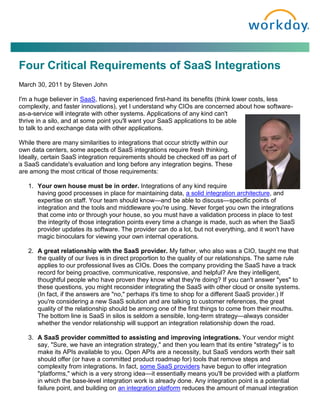
Four Critical Requirements of SaaS Integrations Blog
- 1. Four Critical Requirements of SaaS Integrations March 30, 2011 by Steven John I'm a huge believer in SaaS, having experienced first-hand its benefits (think lower costs, less complexity, and faster innovations), yet I understand why CIOs are concerned about how software- as-a-service will integrate with other systems. Applications of any kind can't thrive in a silo, and at some point you'll want your SaaS applications to be able to talk to and exchange data with other applications. While there are many similarities to integrations that occur strictly within our own data centers, some aspects of SaaS integrations require fresh thinking. Ideally, certain SaaS integration requirements should be checked off as part of a SaaS candidate's evaluation and long before any integration begins. These are among the most critical of those requirements: 1. Your own house must be in order. Integrations of any kind require having good processes in place for maintaining data, a solid integration architecture, and expertise on staff. Your team should know—and be able to discuss—specific points of integration and the tools and middleware you're using. Never forget you own the integrations that come into or through your house, so you must have a validation process in place to test the integrity of those integration points every time a change is made, such as when the SaaS provider updates its software. The provider can do a lot, but not everything, and it won't have magic binoculars for viewing your own internal operations. 2. A great relationship with the SaaS provider. My father, who also was a CIO, taught me that the quality of our lives is in direct proportion to the quality of our relationships. The same rule applies to our professional lives as CIOs. Does the company providing the SaaS have a track record for being proactive, communicative, responsive, and helpful? Are they intelligent, thoughtful people who have proven they know what they're doing? If you can't answer "yes" to these questions, you might reconsider integrating the SaaS with other cloud or onsite systems. (In fact, if the answers are "no," perhaps it's time to shop for a different SaaS provider.) If you're considering a new SaaS solution and are talking to customer references, the great quality of the relationship should be among one of the first things to come from their mouths. The bottom line is SaaS in silos is seldom a sensible, long-term strategy—always consider whether the vendor relationship will support an integration relationship down the road. 3. A SaaS provider committed to assisting and improving integrations. Your vendor might say, "Sure, we have an integration strategy," and then you learn that its entire "strategy" is to make its APIs available to you. Open APIs are a necessity, but SaaS vendors worth their salt should offer (or have a committed product roadmap for) tools that remove steps and complexity from integrations. In fact, some SaaS providers have begun to offer integration "platforms," which is a very strong idea—it essentially means you'll be provided with a platform in which the base-level integration work is already done. Any integration point is a potential failure point, and building on an integration platform reduces the amount of manual integration
- 2. work required, which in turn reduces the risk of something going wrong with your integration. 4. A strong ecosystem. Remember the story of the 1990's Sega Dreamcast video game console? Many considered it ahead of its time, but Sega discontinued it not long after the Sony PlayStation 2 and Microsoft Xbox hit the market, in large part because Dreamcast didn't have enough support from third-party game developers. The Dreamcast story demonstrates that the quality of a provider's ecosystem is just as important—in some instances more important— than the quality of the core system. Does it support integrations with applications or other software services that will use the same data? What are its relationships with other key SaaS providers you're already using or strongly considering? Has it aligned itself with key integrators and consultants? In a nutshell, if you're considering future integrations, it's best to avoid the Dreamcasts of the SaaS world. - Steven Steven John, Workday's Strategic Chief Information Officer, works with customer CIOs and IT groups to help them realize the full benefits of Workday and cloud computing. Steven was most recently the CIO at H. B. Fuller Company, a specialty chemical manufacturer and early Workday customer. Steven was selected by Computerworld magazine as one of its Premier 100 IT Leaders in 2006, and received the CIO Executive Council Leadership award in 2009.
